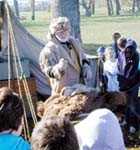Students get glimpse at life 200 years ago

FORT DEFIANCE, Ill. - Looking over his 1803 clothing, a curious visitor asks re-enactor Bob Plummer of Hermann about the pouch stuffed into his wide, leather belt.
"There were no pockets in 1803," he explains. "At least no pockets as we know them." Ladies had pockets sewn inside their waistband for sewing kits, according to Plummer, "but men didn't have pockets." For men, this convenience we take for granted didn't arrive on the scene until invented by Levi Strauss in 1849 for miners to keep their ore samples in. And this is just one of countless ways history is intertwined with the Lewis and Clark story.
Bus loads of area students and other area residents were treated to this living look at life 200 years ago by living history volunteers from Discovery Expedition of St. Charles, a nonprofit organization dedicated to the legacy of Lewis and Clark, who were camped at Fort Defiance Wednesday before heading up the Mississippi.
The official re-enactors of the 2003-2006 Lewis & Clark bicentennial commemoration, they plan to retrace the entire waterway portion of the original expedition.
"We've just completed 1,000 miles. This completes the Eastern legacy," said Plummer. Like the original expedition, they started Aug. 31 in Elizabeth, Penn., and have traveled just like the original expedition. "We've been everywhere they were, on the sites they were to the day," Plummer said.
Events were originally planned for Bird's Point, Mo., near the state historical marker where the local Indians tried to barter away the original expedition's large black dog, but were moved back across the river to where the re-enactors' Illinois camp after it was determined Bird's Point would be too inaccessible for the number of school buses expected.
"We're here for the kids," said Peyton "Bud" Clark of Dearborn, Mich. The re-enactors' mission is "to bring the Lewis and Clark story to the country," Clark said. "It's been very, very rewarding...at times a very emotional experience."
The name is no coincidence: Clark is a direct descendent of the original expedition's co-captain. "William Clark was my great-great-great-grandfather," he said. A second Clark descendent, Charles Clark of St. Louis, has been participating as well by portraying his ancestor during re-enactments.
Clark, whose job on the modern expedition is to share information about the original expedition's guns, said he was excited about the history surrounding his forefather "long before they started talking about the bicentennial." The bicentennial celebration has been the "frosting on the cake," being even bigger and more exciting that he anticipated.
"It's been a lot of fun," Clark said. "It's also a lot of hard work but very gratifying."
Another group circles Clark, and he begins yet another discussion of weapons brought on the expedition including both firelock muskets used for defense and hunting and air guns which were used mostly just to impress the Indians.
Black powder burns slower than modern gunpowder, Clark explains. "When black powder fires it's more of a 'baloooom,'" he said, in contrast to the "pop" of today's guns.
In front of the tent next to Clark's, Al Puknat of Imperial discusses campfire cooking used on the expedition with another group of students. "They only cooked one meal a day," Puknat said.
Puknat points out that the modern crew is using many of the same consumable products used by their predecessors - dried meat and fruits, parched corn, beeswax, coffee beans, sugar.
Further south, Larry Van Tol of St. Louis provides details about the United States infantry uniform he wears. Despite the colors, "this is not a parade uniform," he explains.
Re-enactors have provided living history for tens of thousands of children so far. Clark said the they estimated the number at 30,000 by the time they reached the Ohio falls at Louisville, Ky., at the end of October.
And while the re-enactors are bringing alive history, they have also learned a lot during their journey as local histories "dovetail" into the Lewis and Clark history, Clark said.
In addition to those who are able to come and visit the encampments, thousand more are able to trace the journey through a portable satellite link that is following the expedition. "Like the original Corp of Discovery, we're doing things that have never been done before," Clark said.
Continuing in the footsteps of their historical counterparts, Discovery Expedition re-enactors plan to arrive at Camp DuBois at St. Louis Dec. 12 where they will pause for the winter before continuing their journey May 14.

